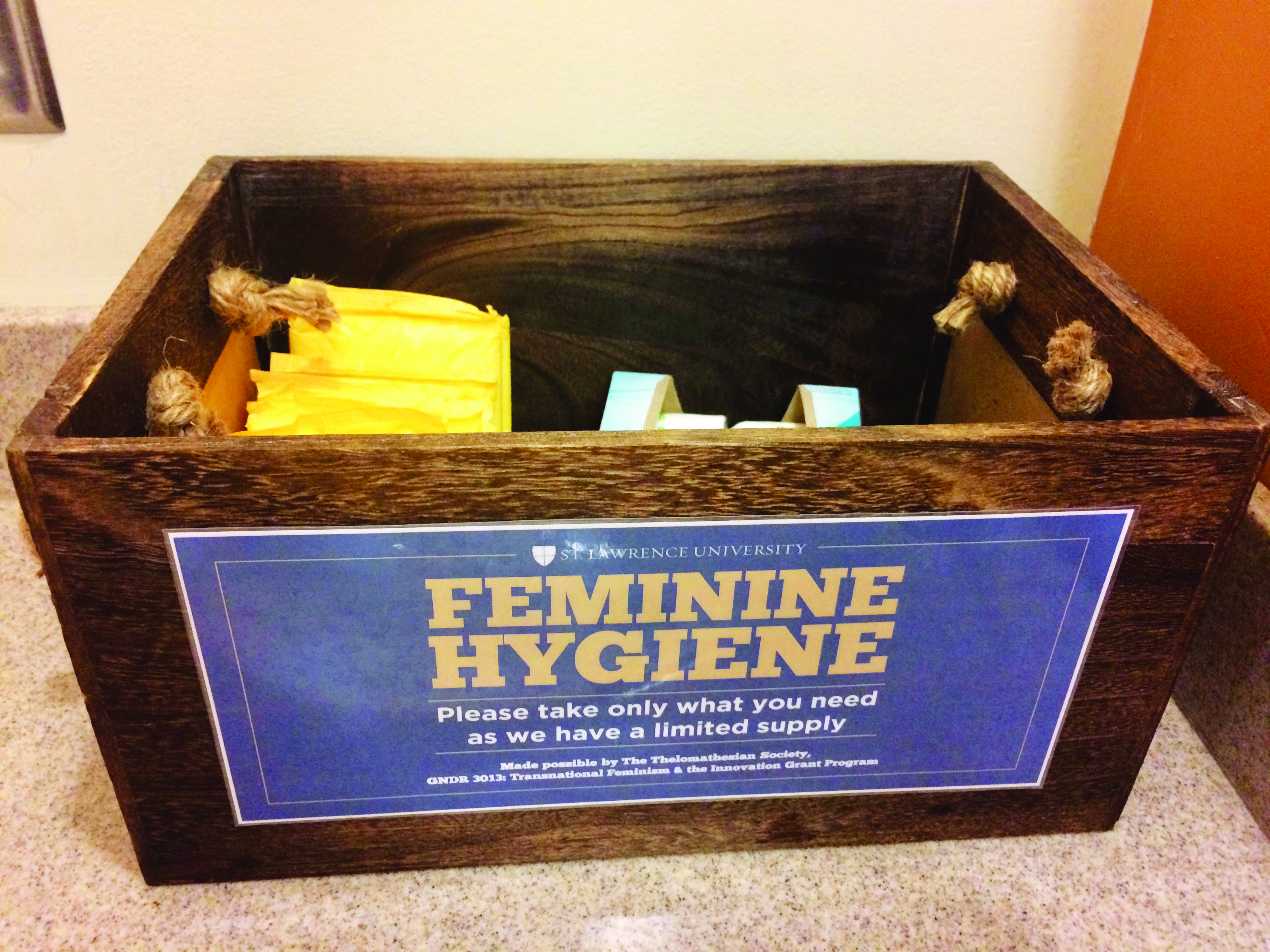By AMANDA BROOKS
EDITOR-AT-LARGE
If you have used the bathrooms in the Student Center or the ODY Library this semester, you have probably noticed a change to the countertops. As the result of an Innovation Grant, Liz Castricone ’17 and R. Christopher DiMezzo ’18, advised by John Robert O’Connor, will be supplying the bathrooms with over 10,000 pads and 20,000 tampons for the semester.
Since 2010, Innovation Grants have been funding projects “that will improve the quality of life at St. Lawrence through curricular, co-curricular, or campus life projects and provide a foundation for St. Lawrence’s future,” according to the St. Lawrence University website. Projects including First-Year Convocation, the Green Bikes program, and Power of Pink week were all originally Innovation Grants dreamed up, planned, and implemented by students, faculty and staff.
Castricone and DiMezzo got the idea for the “Free Feminine Hygiene Products” grant after brainstorming projects with their Transnational Feminism class last semester.
“We’re always provided paper towels and toilet paper, and all of these [products] are for hygiene and basic bodily functions,” Castricone says. “It’s not like you have to ask for them, so why shouldn’t the same thing apply to tampons or pads?” However, stocking public bathrooms with feminine hygiene products isn’t an effort to stop women from having to buy them for themselves. Rather, as Castricone says, “We wanted [the products] in place for people who were caught unexpected.”
The pads and tampons are currently available in two men’s and all three women’s bathrooms in the Student Center, as well as in all of the gender-neutral bathrooms in ODY. The program description notes the reason for putting the products in both men’s and women’s bathrooms as
“Not all people who menstruate identify as women.” “Whatever bathroom you go into, you don’t have to identify as a woman to go and get the tampons or use the products,” explains Castricone. “You can go in whatever bathroom you choose to.”
“The project just reaffirms our University’s mission of inclusion,” DiMezzo elaborates. “At the very least, whether the program is being abused or not – or even if it’s being underused – it’s still there and it sends a message of inclusion to all community members, students, and prospective students.”
Dr. Karen Gagne, Associate Professor of Gender and Sexuality Studies, agrees that this project is working towards both inclusion, and equality for females.
“We provide for male needs as a normal thing in this society, where we don’t do that for female bodies,” she says. “For example, erectile dysfunction medication or Viagra are provided as medical necessities and insured, so money is spent on those things that don’t have to come out of the pockets of the individuals using them.”
Dr. Gagne goes on to explain the high cost of having periods. “The female body has probably 40 years of periods, once a month. Depending on the person, what the person goes through, in terms of clothing, bedding material, and actual products, is a lot. And also pain medication that might go with it.”
This doesn’t even cover the cost of the products themselves. The Washington Post reported last year that women pay about seven dollars per month for pads and tampons, which adds up to over $3,000 over the course of 40 years. Tampons are also taxed in all but nine of the United States, as they are not listed as “necessities.” This “tampon tax” is just one facet of gender inequality that projects like Castricone and DiMezzo’s Innovation Grant are working towards correcting.
Castricone and DiMezzo have heard overwhelmingly positive feedback towards the project so far. Grace Galanti ’17 echoes their sentiments about bathroom products already being provided; “You don’t pay for toilet paper, so why should you have to pay for pads and tampons?” Ethan Collins ’18 notes “There’s definitely a chunk of male students on campus that aren’t too well-read on the topic of gender inequality in the restrooms, so this [project] is not only a great resource for people that need the products, but also a great educational tool.”
A major concern of the project creators is that people are stealing the supplies to stock up in their rooms. “But that’s something we’re hoping will stop after folks realize that we’re going to keep re-supplying it,” DiMezzo explains. “They’re always going to be there and available to you.”
DiMezzo says he is going to try to build it into the Thelmo executive board’ budget for next semester. “$5,000 a semester wouldn’t make a huge dent into the Thelmo budget, but would also make a meaningful impact on campus.”



